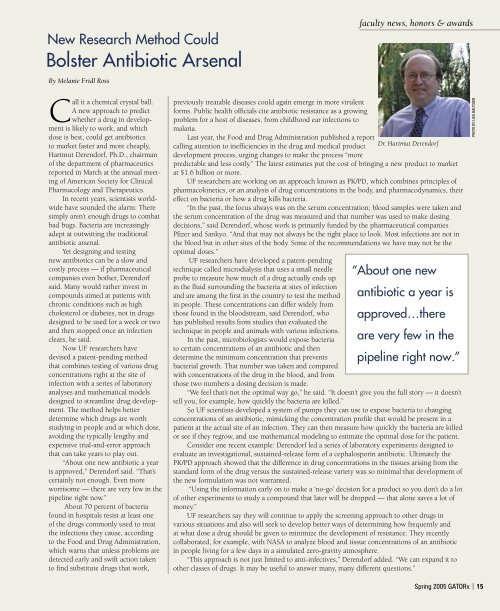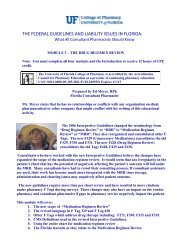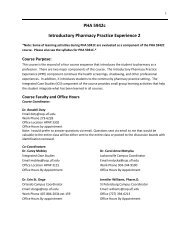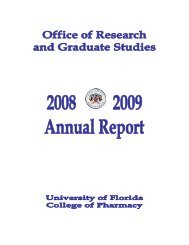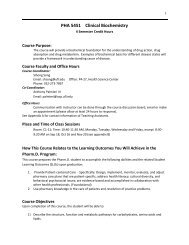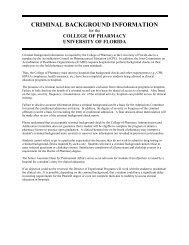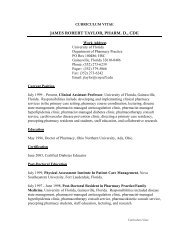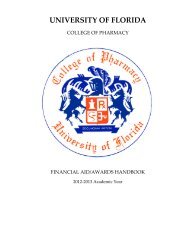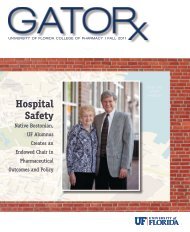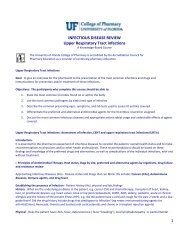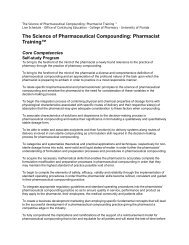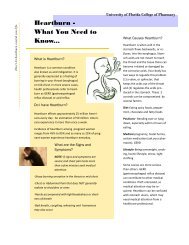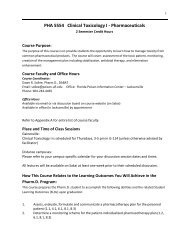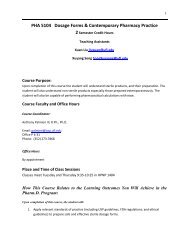GATORx W05.indd - College of Pharmacy - University of Florida
GATORx W05.indd - College of Pharmacy - University of Florida
GATORx W05.indd - College of Pharmacy - University of Florida
Create successful ePaper yourself
Turn your PDF publications into a flip-book with our unique Google optimized e-Paper software.
New Research Method Could<br />
Bolster Antibiotic Arsenal<br />
By Melanie Fridl Ross<br />
Call it a chemical crystal ball.<br />
A new approach to predict<br />
whether a drug in development<br />
is likely to work, and which<br />
dose is best, could get antibiotics<br />
to market faster and more cheaply,<br />
Hartmut Derendorf, Ph.D., chairman<br />
<strong>of</strong> the department <strong>of</strong> pharmaceutics<br />
reported in March at the annual meeting<br />
<strong>of</strong> American Society for Clinical<br />
Pharmacology and Therapeutics.<br />
In recent years, scientists worldwide<br />
have sounded the alarm: There<br />
simply aren’t enough drugs to combat<br />
bad bugs. Bacteria are increasingly<br />
adept at outwitting the traditional<br />
antibiotic arsenal.<br />
Yet designing and testing<br />
new antibiotics can be a slow and<br />
costly process — if pharmaceutical<br />
companies even bother, Derendorf<br />
said. Many would rather invest in<br />
compounds aimed at patients with<br />
chronic conditions such as high<br />
cholesterol or diabetes, not in drugs<br />
designed to be used for a week or two<br />
and then stopped once an infection<br />
clears, he said.<br />
Now UF researchers have<br />
devised a patent-pending method<br />
that combines testing <strong>of</strong> various drug<br />
concentrations right at the site <strong>of</strong><br />
infection with a series <strong>of</strong> laboratory<br />
analyses and mathematical models<br />
designed to streamline drug development.<br />
The method helps better<br />
determine which drugs are worth<br />
studying in people and at which dose,<br />
avoiding the typically lengthy and<br />
expensive trial-and-error approach<br />
that can take years to play out.<br />
“About one new antibiotic a year<br />
is approved,” Derendorf said. “That’s<br />
certainly not enough. Even more<br />
worrisome — there are very few in the<br />
pipeline right now.”<br />
About 70 percent <strong>of</strong> bacteria<br />
found in hospitals resist at least one<br />
<strong>of</strong> the drugs commonly used to treat<br />
the infections they cause, according<br />
to the Food and Drug Administration,<br />
which warns that unless problems are<br />
detected early and swift action taken<br />
to find substitute drugs that work,<br />
previously treatable diseases could again emerge in more virulent<br />
forms. Public health <strong>of</strong>ficials cite antibiotic resistance as a growing<br />
problem for a host <strong>of</strong> diseases, from childhood ear infections to<br />
malaria.<br />
Last year, the Food and Drug Administration published a report<br />
calling attention to inefficiencies in the drug and medical product<br />
development process, urging changes to make the process “more<br />
faculty news, honors & awards<br />
predictable and less costly.” The latest estimates put the cost <strong>of</strong> bringing a new product to market<br />
at $1.6 billion or more.<br />
UF researchers are working on an approach known as PK/PD, which combines principles <strong>of</strong><br />
pharmacokinetics, or an analysis <strong>of</strong> drug concentrations in the body, and pharmacodynamics, their<br />
effect on bacteria or how a drug kills bacteria.<br />
“In the past, the focus always was on the serum concentration; blood samples were taken and<br />
the serum concentration <strong>of</strong> the drug was measured and that number was used to make dosing<br />
decisions,” said Derendorf, whose work is primarily funded by the pharmaceutical companies<br />
Pfizer and Sankyo. “And that may not always be the right place to look. Most infections are not in<br />
the blood but in other sites <strong>of</strong> the body. Some <strong>of</strong> the recommendations we have may not be the<br />
optimal doses.”<br />
UF researchers have developed a patent-pending<br />
technique called microdialysis that uses a small needle<br />
probe to measure how much <strong>of</strong> a drug actually ends up<br />
in the fluid surrounding the bacteria at sites <strong>of</strong> infection<br />
and are among the first in the country to test the method<br />
in people. These concentrations can differ widely from<br />
those found in the bloodstream, said Derendorf, who<br />
has published results from studies that evaluated the<br />
technique in people and animals with various infections.<br />
In the past, microbiologists would expose bacteria<br />
to certain concentrations <strong>of</strong> an antibiotic and then<br />
determine the minimum concentration that prevents<br />
bacterial growth. That number was taken and compared<br />
with concentrations <strong>of</strong> the drug in the blood, and from<br />
those two numbers a dosing decision is made.<br />
Dr. Hartmut Derendorf<br />
“ About one new<br />
antibiotic a year is<br />
approved…there<br />
are very few in the<br />
pipeline right now.”<br />
“We feel that’s not the optimal way go,” he said. “It doesn’t give you the full story — it doesn’t<br />
tell you, for example, how quickly the bacteria are killed.”<br />
So UF scientists developed a system <strong>of</strong> pumps they can use to expose bacteria to changing<br />
concentrations <strong>of</strong> an antibiotic, mimicking the concentration pr<strong>of</strong>ile that would be present in a<br />
patient at the actual site <strong>of</strong> an infection. They can then measure how quickly the bacteria are killed<br />
or see if they regrow, and use mathematical modeling to estimate the optimal dose for the patient.<br />
Consider one recent example: Derendorf led a series <strong>of</strong> laboratory experiments designed to<br />
evaluate an investigational, sustained-release form <strong>of</strong> a cephalosporin antibiotic. Ultimately the<br />
PK/PD approach showed that the difference in drug concentrations in the tissues arising from the<br />
standard form <strong>of</strong> the drug versus the sustained-release variety was so minimal that development <strong>of</strong><br />
the new formulation was not warranted.<br />
“Using the information early on to make a ‘no-go’ decision for a product so you don’t do a lot<br />
<strong>of</strong> other experiments to study a compound that later will be dropped — that alone saves a lot <strong>of</strong><br />
money.”<br />
UF researchers say they will continue to apply the screening approach to other drugs in<br />
various situations and also will seek to develop better ways <strong>of</strong> determining how frequently and<br />
at what dose a drug should be given to minimize the development <strong>of</strong> resistance. They recently<br />
collaborated, for example, with NASA to analyze blood and tissue concentrations <strong>of</strong> an antibiotic<br />
in people living for a few days in a simulated zero-gravity atmosphere.<br />
“This approach is not just limited to anti-infectives,” Derendorf added. “We can expand it to<br />
other classes <strong>of</strong> drugs. It may be useful to answer many, many different questions.”<br />
PHOTO BY LISA BALTOZER<br />
Spring 2005 <strong>GATORx</strong> | 15


